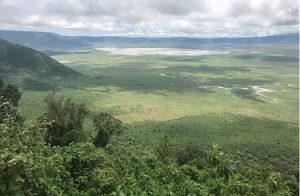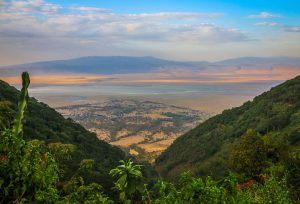About Park
There are plenty of hippos around the lovely Ngoitoktok Springs picnic site, and Lake Magadi attracts flocks of flamingos to its shallows in the rainy  season. Lereal Forest (which has a less appealing picnic site, and is the starting point for the Lereal or Lerai ascent road) is good for elephants, of which there are 200 to 300 in the crater. Predators include around 600 spotted hyenas, 55 lions (at last count), and both golden and black-backed jackals. These predators are sustained by large numbers of resident herbivores, with wildebeest, zebras, buffaloes and Grant’s gazelles the most common. Less commonly seen are elands, warthogs, hartebeests, bushbucks, waterbucks and bohor reedbucks. Around 20% of the wildebeest and zebras migrate annually between the crater and the Serengeti. Another huge drawcard is the chance to see the critically endangered black rhino – around 30 inhabit the crater floor, and they’re most often seen between the Lereal Forest and the Lemala ascent-descent road.
season. Lereal Forest (which has a less appealing picnic site, and is the starting point for the Lereal or Lerai ascent road) is good for elephants, of which there are 200 to 300 in the crater. Predators include around 600 spotted hyenas, 55 lions (at last count), and both golden and black-backed jackals. These predators are sustained by large numbers of resident herbivores, with wildebeest, zebras, buffaloes and Grant’s gazelles the most common. Less commonly seen are elands, warthogs, hartebeests, bushbucks, waterbucks and bohor reedbucks. Around 20% of the wildebeest and zebras migrate annually between the crater and the Serengeti. Another huge drawcard is the chance to see the critically endangered black rhino – around 30 inhabit the crater floor, and they’re most often seen between the Lereal Forest and the Lemala ascent-descent road.
The reason for all this abundance is the presence of water, both from the permanent springs that sustain the swamps, and the permanent streams and rivers fed by run-off from the crater-rim forests.
Ngorongoro Crater: Wildlife Highlights
Ngorongoro Crater is one of the most likely areas in Tanzania to see the endangered Black Rhino, as a small population is thriving in this idyllic and protected environment. It is currently one of the few areas where they continue to breed in the wild. Your chances of encountering leopard here are also good, and fabulous black-maned lions. Many flamingos are also attracted to the soda waters of Lake Magadi.
Ngorongoro Crater: Maasai village trips
Part of the reason behind the Ngorongoro Conservation Area has been to preserve the environment for the Maasai people who were diverted from the Serengeti  Plains. Essentially nomadic people, they build temporary villages in circular homesteads called bomas. There are possibilities to visit a couple of these now, which have been opened up for tourists to explore. Here you can see how the huts are built in a strict pattern of order according to the chronological order of the wives, and experience what it must be like to rely on warmth and energy from a fire burning at the heart of a cattle dung dwelling with no chimney. These proud cattle herding people have a great history as warriors, and even though they are no longer allowed to build villages inside, they continue to herd their cattle into the crater to graze and drink, regardless of the predators nearby.
Plains. Essentially nomadic people, they build temporary villages in circular homesteads called bomas. There are possibilities to visit a couple of these now, which have been opened up for tourists to explore. Here you can see how the huts are built in a strict pattern of order according to the chronological order of the wives, and experience what it must be like to rely on warmth and energy from a fire burning at the heart of a cattle dung dwelling with no chimney. These proud cattle herding people have a great history as warriors, and even though they are no longer allowed to build villages inside, they continue to herd their cattle into the crater to graze and drink, regardless of the predators nearby.
3 days in Ngorongoro Conservation Area
Day 1 – Arusha – Ngorongoro
Non game-viewing travel time: 4 hours
Distance: 190 km
Pick up from Arusha and transfer to the Ngorongoro Conservation area. We arrive in time for lunch at the lodge and after lunch we will descend over 600 meters into the crater to view wildlife for an afternoon safari tour.
Supported by a year round water supply and fodder, the Ngorongoro National Park supports a vast variety of animals, which include herds of wildebeest, zebra, buffalo, eland, warthog, hippo, and giant African elephants. Another big draw card to this picturesque national park, is it’s dense population of predators, which include lions, hyenas, jackals, cheetahs and the ever-elusive leopard, which sometimes requires a trained eye to spot. We will visit Lake Magadi, a large but shallow alkaline lake in the south western corner, which is one of the main features of the crater. A large number of flamingos, hippos and other water birds can usually been seen here.
Dinner and overnight as per the standard and type of accommodation option requested.
Day 2 – Ngorongoro – Ndutu
Non game-viewing travel time: 2 hours
Distance: 90 km
After breakfast we will head to the Lake Ndutu area, situated in the Ngorongoro conservation area, part of the southern Serengeti eco-system. Lake Ndutu is alkaline, like most of the other Rift lakes, however the water is still drinkable and used by a wide array of local wildlife.
We arrive in time for lunch at the lodge or camp, and after lunch we will do an afternoon game drive in the Ndutu area. The majority of the wildebeest migration can normally be found on the short-grass plains from December to April. The area is usually heavily populated with elephant, birds and resident game.
Dinner and overnight as per the standard and type of accommodation option requested.
Day 3 – Ndutu
After breakfast, enjoy a full day game drive in the Ndutu area. Explore the range of different habitats that include swamps, woodland, soda lakes and the world famous Serengeti short grass plains. See great herds of wildebeest and zebra. During a short time frame around February, normally lasting for about 3 weeks, the majority of the wildebeest calve. The sea of grass provides little cover and the young are easy pickings for a variety of predators. Wildebeest calves can run minutes after they are born and within 3 days they are normally strong enough to keep up with the herd.
Lunch, Dinner and overnight as per the standard and type of accommodation option requested.
